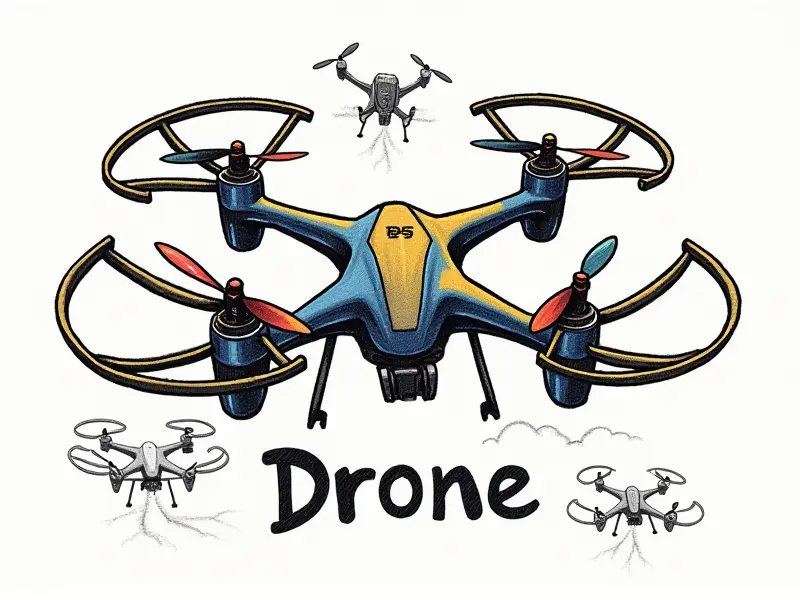FPV antenna placement?

Optimal FPV Antenna Placement Guide
Flying a drone in first-person view (FPV) can be an exhilarating experience, but achieving optimal performance requires more than just piloting skills. One of the most critical components of your setup is the placement and orientation of your FPV antennas. Proper antenna positioning ensures clear video transmission, reduces interference, and maximizes range. This guide will walk you through the best practices for placing FPV antennas correctly.
Maximize Range with Perfect FPV Antennas
The goal of any FPV setup is to achieve the maximum possible range while maintaining a clear video feed. To accomplish this, it's essential to place your antennas in positions that minimize signal interference and maximize transmission efficiency. Here are some key points to consider:
- Antenna Orientation: Ensure that both the transmitter (TX) and receiver (RX) antennas are aligned properly. Horizontal polarization is generally preferred for FPV, as it offers better range in open spaces.
- Avoid Obstructions: Keep your antennas away from metal objects, buildings, or any other potential sources of interference. Metal can block RF signals and significantly reduce performance.
- High Placement: Elevating your RX antenna above ground level can improve reception by reducing the impact of terrain on signal strength.
Best Practices for FPV Antenna Setup
A well-placed antenna setup is crucial to achieving optimal performance. Here are some best practices that every FPV enthusiast should follow:
- Select the Right Antennas: Use high-quality antennas designed specifically for FPV applications. Planar inverted-F antennas (PIFA) or patch antennas are popular choices due to their compact size and effectiveness.
- Balanced TX/RX: Ensure that both your transmitter and receiver have similar quality and type of antennas to maintain balanced performance.
- Cable Management: Keep cables short and secure. Long cables can introduce signal loss, while loose cables may cause interference or physical damage.
How to Place FPV Antennas Correctly
The placement of your antennas is critical for achieving the best possible performance. Here’s how you should go about it:
- RX Antenna Placement: Mount your RX antenna on a high point, such as atop a pole or mast. This helps reduce interference from ground-based obstructions.
- TX Antenna Placement: Position the TX antenna directly above the drone’s flight controller for optimal signal transmission. Ensure it is securely mounted to prevent movement during flight.
Achieving Optimal FPV Performance with Antenna Placement
To get the most out of your FPV setup, you need to fine-tune your antenna placement based on specific conditions and requirements:
- Testing and Adjustment: Test different placements during test flights or ground tests. Observe how signal quality changes with varying positions.
- Environmental Factors: Consider the environment you’ll be flying in. Urban areas may require more vertical placement to avoid building interference, while open fields can benefit from horizontal polarization.
Essential Guide to FPV Antenna Mounting Points
The choice of mounting points for your antennas is crucial for both stability and performance:
- Mounting Accessories: Use reliable mounting accessories like rubber bands, zip ties, or specialized antenna mounts. These ensure that your antennas remain secure during flight.
- Multicopter Mounts: For multirotor drones, consider using dedicated FPV antenna mounts designed to fit specific frame types and sizes.
Secrets of Effective FPV Antenna Positioning
To truly master FPV antenna placement, you need to understand the nuances that separate good setups from great ones:
- Polarization Alignment: Ensure that both TX and RX antennas are aligned in terms of polarization. This can significantly improve signal quality.
- Antenna Spacing: Keep your TX and RX antennas at least 10 inches apart to avoid self-interference, especially when using circularly polarized antennas.
Enhance FPV Performance with Smart Antenna Placement
Smart placement of your FPV antennas can enhance performance in several ways:
- Battery Interference: Keep antennas away from high-frequency electronic components like battery packs, which can cause interference.
- Multipath Signals: Be aware of multipath signals caused by reflections off buildings or terrain. Adjust antenna placement to minimize these effects.
Ultimate Guide to FPV Antenna Orientation
The orientation of your antennas can make a significant difference in signal quality and range:
- Horizontal vs Vertical Polarization: Horizontal polarization is generally better for open spaces, while vertical polarization works well in urban environments with many obstructions.
- Antenna Alignment: Align your antennas so that they face each other directly. Any deviation can reduce signal strength and clarity.
Top Tips for FPV Drone Antenna Placement
Here are some top tips to help you achieve the best possible performance with your FPV drone:
- Use High-Quality Cables: Invest in quality coaxial cables that minimize signal loss and interference.
- Monitor Signal Quality: Use a signal strength indicator to monitor and adjust your antenna placement during setup and testing.
Essential FPV Antenna Location Strategies
To get the most out of your FPV system, consider these essential strategies for placing your antennas:
- Field Testing: Conduct extensive field tests in various environments to determine the best antenna placement.
- Experiment with Different Antenna Types: Try different types and configurations of FPV antennas to find what works best for your specific setup.
Conclusion
Properly placing your FPV antennas is a critical step in achieving optimal performance. By following the guidelines outlined in this guide, you can ensure clear video transmission, maximize range, and reduce interference. Experimentation and testing are key to finding the perfect setup for your specific needs. With the right antenna placement, you'll be ready to enjoy flawless FPV flights every time.

